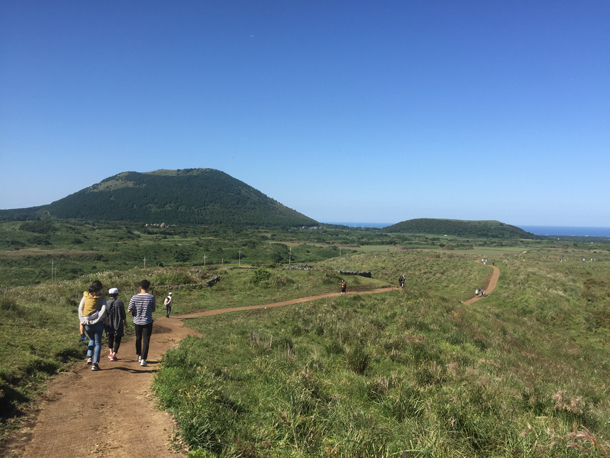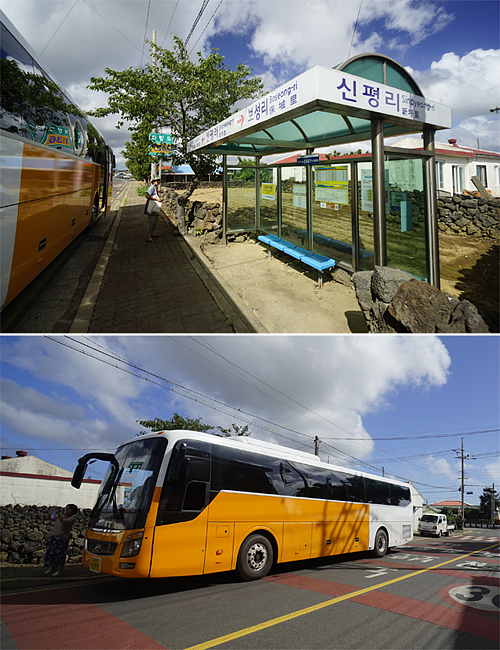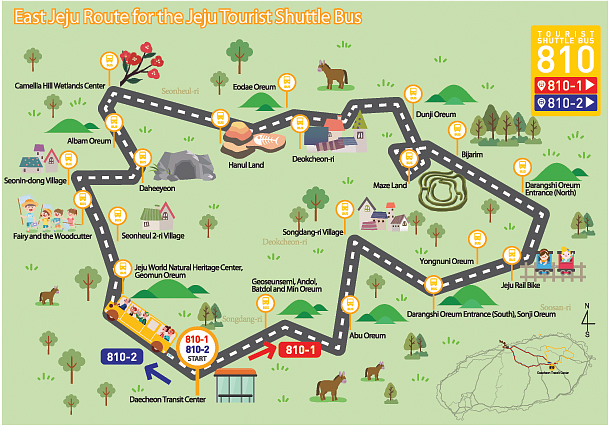Buses give travelers access to secluded spots : The Jeju Tourist Shuttle Bus offers tourists without rental cars a chance to visit hard-to-reach attractions

Families visiting Jeju Island take a light walk along the trail at Yongnuni Oreum, one of the most popular parasitic cone volcanos on the island. [LEE SUN-MIN]
However, that has changed after Jeju reformed its bus system and launched a new travel bus that takes people into the center of the island’s nature preserves for a fair price.
Yellow Jeju Tourist Shuttle Buses 810 and 820 take passengers to major travel destinations around Jeju. The 810 bus covers the eastern part of the island - home to many parks and oreum, or parasitic cones formed by volcanic material on the island - while the 820 covers the western side of the island, known for its museums and amusement parks. Each of the buses run in two directions, so travelers can easily access wherever they are going.

The newly-created Jeju Tourist Shuttle Bus, above, takes visitors to bus stops close to major travel destinations on Jeju Island. [JEJU TOURISM ORGANIZATION]
There is always a tour guide on board to assist travelers. They inform passengers where the bus is going and offer detailed information on where to go visit and how to best enjoy the museums, oreums and parks that are accessible from the bus stops.
While most bus stops on the route around the island’s east side are close to most of the major destinations like Yongnuni Oreum, the Darangshi Oreum, one of the highest parasitic volcanos on Jeju, is an exception. From the bus stop, it takes about 30 minutes to walk to the entrance. After another 30-minute hike up to the top, you will be able to see a spectacular view of the ocean on one side and a range of oreum on the other. On a clear day, hikers can get a view of the Seongsan Sunrise Peak as well.
From there, make your way over to Yongnuni Oreum, a 30- to 40-minute walk. An easier climb than the hike up to Darangshi, this trail starts on a horse farm, where some horses are known to eagerly follow hikers as they walk by. Be sure to check the bus schedule in advance so that you don’t need to wait too long at the stop for a bus to come.

The bus runs 16 times a day from 8:30 a.m. until its last run at 5:30 p.m. The location of the buses can be tracked on bus.jeju.go.kr as well as on mobile apps that show bus routes. The bus route takes about one hour and 20 minutes from start to finish.
For more information about the Jeju Tourist Shuttle Bus and general travel tips on Jeju, go to www.visitjeju.net.
BY LEE SUN-MIN [summerlee@joongang.co.kr]










with the Korea JoongAng Daily
To write comments, please log in to one of the accounts.
Standards Board Policy (0/250자)